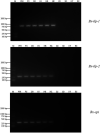Genes Encoding Potential Molecular Mimicry Proteins as the Specific Targets for Detecting Bursaphelenchus xylophilus in PCR and Loop-Mediated Isothermal Amplification Assays
- PMID: 35646005
- PMCID: PMC9131030
- DOI: 10.3389/fpls.2022.890949
Genes Encoding Potential Molecular Mimicry Proteins as the Specific Targets for Detecting Bursaphelenchus xylophilus in PCR and Loop-Mediated Isothermal Amplification Assays
Abstract
The introduction of the pine wood nematode (Bursaphelenchus xylophilus) to new areas has affected the international forestry industry because this pathogen causes pine wilt disease (PWD). Therefore, methods for the accurate and reliable detection of B. xylophilus are essential for controlling and managing this pest. The PCR and Loop-Mediated Isothermal Amplification (LAMP) techniques developed in this study involve species-specific primer sets targeting B. xylophilus genes encoding potential molecular mimicry proteins (Bx-tlp-1, Bx-tlp-2, and Bx-cpi), which are associated with pathogenicity. The PCR and LAMP results revealed that the primers were specific for B. xylophilus Bx-tlp-1, Bx-tlp-2, and Bx-cpi. Moreover, our LAMP assay targeting Bx-tlp-1 conducted at 63°C detected B. xylophilus within 20 min and B. xylophilus from Monochamus alternatus or M. saltuarius within 30 min. The lower limits of detection for the LAMP and PCR assays were 10 pg and 10 ng genomic DNA, respectively, implying these assays may be useful for the rapid detection of B. xylophilus in pine forests. Designing primers specific for Bx-tlp-1, Bx-tlp-2, and Bx-cpi enabled the relatively rapid detection of B. xylophilus isolates as well as M. alternatus or M. saltuarius carrying B. xylophilus. These primers, which were designed following a thorough functional analysis of key B. xylophilus pathogenicity-related genes, may be useful for developing improved assays for the early diagnosis and prevention of PWD.
Keywords: Bursaphelenchus xylophilus; PCR and LAMP; potential molecular mimicry proteins; rapid detection; specific target.
Copyright © 2022 Meng, Liu, Li and Zhang.
Conflict of interest statement
The authors declare that the research was conducted in the absence of any commercial or financial relationships that could be construed as a potential conflict of interest.
Figures




Similar articles
-
Detection Methods for Pine Wilt Disease: A Comprehensive Review.Plants (Basel). 2024 Oct 14;13(20):2876. doi: 10.3390/plants13202876. Plants (Basel). 2024. PMID: 39458823 Free PMC article. Review.
-
Potential Molecular Mimicry Proteins Responsive to α-pinene in Bursaphelenchus xylophilus.Int J Mol Sci. 2020 Feb 1;21(3):982. doi: 10.3390/ijms21030982. Int J Mol Sci. 2020. PMID: 32024175 Free PMC article.
-
Expression of the Thaumatin-Like Protein-1 Gene (Bx-tlp-1) from Pine Wood Nematode Bursaphelenchus xylophilus Affects Terpene Metabolism in Pine Trees.Phytopathology. 2022 Apr;112(4):888-897. doi: 10.1094/PHYTO-07-21-0289-R. Epub 2022 Mar 21. Phytopathology. 2022. PMID: 35311527
-
Thaumatin-Like Protein-1 Gene (Bx-tlp-1) Is Associated with the Pathogenicity of Bursaphelenchus xylophilus.Phytopathology. 2019 Nov;109(11):1949-1956. doi: 10.1094/PHYTO-03-19-0082-R. Epub 2019 Sep 30. Phytopathology. 2019. PMID: 31573422
-
[Ecological relationships between Bursaphelenchus xylophilus and its companion microorganisms].Ying Yong Sheng Tai Xue Bao. 2011 Mar;22(3):810-5. Ying Yong Sheng Tai Xue Bao. 2011. PMID: 21657042 Review. Chinese.
Cited by
-
Bursaphelenchus xylophilus detection and analysis system based on CRISPR - Cas12.Front Plant Sci. 2022 Dec 15;13:1075838. doi: 10.3389/fpls.2022.1075838. eCollection 2022. Front Plant Sci. 2022. PMID: 36589043 Free PMC article.
-
Evolution of parasitism genes in the plant parasitic nematodes.Sci Rep. 2024 Feb 14;14(1):3733. doi: 10.1038/s41598-024-54330-3. Sci Rep. 2024. PMID: 38355886 Free PMC article.
-
Establishment of a Sensitive and Reliable Droplet Digital PCR Assay for the Detection of Bursaphelenchus xylophilus.Plants (Basel). 2024 Sep 26;13(19):2701. doi: 10.3390/plants13192701. Plants (Basel). 2024. PMID: 39409571 Free PMC article.
-
Detection Methods for Pine Wilt Disease: A Comprehensive Review.Plants (Basel). 2024 Oct 14;13(20):2876. doi: 10.3390/plants13202876. Plants (Basel). 2024. PMID: 39458823 Free PMC article. Review.
References
-
- Cardoso J. M. S., Fonseca L., Abrantes I. (2012). Direct molecular detection of the pine wood nematode, Bursaphelenchus xylophilus, from pine wood, bark and insect vector. Eur. J. Plant Pathol. 133, 419–425. doi: 10.1007/s10658-011-9915-y - DOI
-
- Cheng H., Lin M., Li W., Fang Z. (1983). The occurrence of a pine wilting disease caused by a nematode found in Nanjing. Forest Pest Dis. 4, 1–5.
-
- Hu Y. Q., Kong X. C., Wang X. R., Zhong T. K., Zhu X. W., Mota M. M., et al. . (2011). Direct PCR-based method for detecting Bursaphelenchus xylophilus, the pine wood nematode in wood tissue of Pinus massoniana. Forest Pathol. 41, 165–168. doi: 10.1111/j.1439-0329.2010.00692.x - DOI
-
- Huang L., Ye J. R., Wu X. Q., Xu X. L., Sheng J. M., Zhou Q. X. (2010). Detection of the pine wood nematode using a real-time PCR assay to target the DNA topoisomerase I gene. Eur. J. Plant Pathol. 127, 89–98. doi: 10.1007/s10658-009-9574-4 - DOI
LinkOut - more resources
Full Text Sources

